Announcing the 2024 Nickerson Beach IPT
|
|
Join me to photograph Black Skimmers, Common Terns, American Oystercatchers, and more! |
The Summer 2024 Nickerson Beach 3 1/2 day Terns, Skimmers, & Oystercatchers IPTs
July 29 – August 1, 2024. 3 1/2 days: Afternoon session on MON 29 July through the afternoon session on THURS 8 August: $2099.00. Limit: 6. Openings: 5
August 5-8 2024. 3 1/2 days: Afternoon session on MON 5 August through the afternoon session on THURS 1 August: $2099.00. Limit: 6.
Join me at Nickerson Beach Park this summer to photograph Black Skimmers, Common Terns, and American Oystercatchers. The trip is timed so that we should get to photograph tiny chicks as well as fledglings. There will be lots of flight photography including adults flying with baitfish and mole crabs. Creating great images of the chicks being fed is a challenge but I will do my best to help you toward that end. We will get to photograph a variety of breeding behaviors including courtship, sitting on (incubating) eggs, chick feeding, and more. We may get to photograph pre-dawn and early evening blastoffs. There is generally great afternoon skimmer flight photography that includes frequent midair battles sunny days. And with luck, we might even see a few tiny chicks in addition to fledged and flying young. We will also get to photograph the life cycle of American Oystercatcher. This will likely include nests with eggs and small chicks, young being fed, and surely a few fledglings.
Nesting Piping Plover is also possibly. There will be lots of gulls to photograph; most years I am able to find a few lesser black-backeds of varying ages in addition to the Herring, Ring-billed, and Great Black-backed Gulls. You will learn to identify and age the various gull species. There will likely be some Willets feeding along the surf and with luck we might get to photograph a handsome juvenile or two. In addition to the locally breeding shorebirds, we will likely get to see some southbound migrant arctic-and sub-arctic breeding shorebird species such as Sanderling, Semipalmated Plover, and maybe even Red Knot.
|
|
Clockwise from upper left around and back to center: Black Skimmer pair with chick; Black Skimmer fledgling skimming; Black Skimmer with large needlefish; Black Skimmer large chick; Black Skimmer fledgling taking flight; Black Skimmer adult with killifish; Black Skimmer adult landing near nest; Black Skimmer in midair chase; and Black Skimmers at dawn in the red light district. |
Afternoon sessions will run from 5:30 till sunset (assuming that entry policies are as they were in 2023. Morning sessions will run from pre-dawn till about 9:00 or 9:30am, roughly 3 1/2 hours.
Many folks head home feeling that while our time in the field was fabulous and productive, that the working brunch sessions were even more valuable. During image review you will learn to select the best images from several thousand made with your 20- and 30 fps (or 120 fps!) camera bodies. And we will process a few images and distribute the screen capture videos for you to learn from after the trip. And all IPTs offer follow-up image critiques.
Change your life: sign up for this IPT today. Please shoot me an e-mail if you would like to explore the possibility of renting some Sony gear (including an a1) from me.
|
|
Clockwise from upper left around and back to center: Adult American Oystercatcher foraging at sunrise; Adult American Oystercatcher posing on clean sand; predawn skimmer flock blur; Black Skimmer large chick; Black Skimmer landing at nest on cloudy day; Black Skimmer large chick; Black Skimmer sunrise group blur; Black Skimmer adult with Atlantic Silversides; juvenile Semipalmated Plover, and photographer with oystercatcher family. |
Some of What You Will Learn on a Nickerson Beach IPT
- 1- The basics and fine points of digital exposure; how to get the right exposure every time after making a single test exposure (or before if you are using SONY gear).
- 2- How and why to work in Manual mode (even if you’re scared of it).
- 3- How to approach free and wild birds without disturbing them.
- 4- Lots about bird behavior and how to use that knowledge to help you create better images.
- 6- To spot the good and great situations and to choose the best perspective.
- 7- To see, evaluate, and understand the light.
- 8- To design pleasing images by mastering your camera’s AF system.
- 9- And perhaps most importantly, to evaluate wind and sky conditions and understand how they affect bird photography. You will learn where and when to be (and why).
- 10- More than you could ever imagine.
|
|
Clockwise from upper left around and back to center: Black Skimmer pair with chick; Common Tern landing at nest with small baitfish; large Common Tern chick on pristine beach; American Oystercatchers courtship flight; Common Tern with pipefish; Common Tern fledgling; American Oystercatcher on eggs in high wind; American Oystercatcher nest with three eggs; and Black Skimmer midair battle. |
The Details
We will be on the beach very early to enjoy sunrise. The morning sessions will run about 3 1/2 hours. Afternoon sessions will begin at 5:30 and run till sunset. There is never a set schedule on an IPT — we adapt to the conditions. On cloudy mornings with the right wind, we may opt to photograph till 11:30am or so and skip the afternoon session. That especially when the afternoon weather is looking iffy.
There will be a Photoshop/Image Review session before and after brunch (included) each full day. That will be followed by Instructor Nap Time. Each of these IPTs will run with only a single registrant as I do not like disappointing anyone. The best airports are JFK or Islip (if you have lots of Southwest points). Once you register, you will receive an e-mail with lodging information. Do know that it is always best if IPT folks stay in the same general area (rather than at home or at a friend’s place a good distance away).
Folks attending this IPT will be out in the field ridiculously early and stay out late to take advantage of sunrise and sunset colors; this is pretty much a staple on almost all BIRDS AS ART Instructional Photo-Tours. Doing so will often present unique photographic opportunities, opportunities that will be missed by those who need their beauty rest and those who need to get home for a proper dinner. I really love it when I am leaving the beach at 9:00am on a sunny morning after a great session just as a carful or two of well-rested photographers are arriving … We may be getting our feet wet on occasion, especially in the mornings, but those who wish to keep their feet 100% dry can do so.
Your $699 deposit is due now. Credit cards are OK for that. You can register by calling Jim or Jennifer during weekday business hours at 863-692-0906 with a credit card in hand. Once you leave a deposit, you will receive an e-mail with your balance statement and instructions for sending your balance check. Those who wish to pay for the trip in one fell swoop via check may do so by making the check out to BIRDS AS ART and then mailing it to BIRDS AS ART, PO BOX 7245, Indian Lake Estates, FL 33855. You will receive a confirmation e-mail with detailed instructions, and clothing and gear advice right after you register. Please shoot me an e-mail if you plan to register or if you have any questions.
IPT veterans and couples or friends signing up together may e-mail for discount information.
My Call
Though I loved the background and the clean subject in Image #1, Bald Eagle in flight with spruce tree background, my very favorite was Image #4, Adult and young Bald Eagle squabbling.
Your Call?
Which of today’s four featured Nickerson Beach images is the strongest. Why?
What’s Up?
Today is Thursday 7 March 2024. I will be receiving a FedEx package today from Bedfords: in it will be my very own Sony 300mm f/2.8 lens and a Sony A9 III. I will be heading to Stick Marsh tomorrow as the sky conditions and wind direction are looking pretty good. If you would like to join me for a morning In-the-Field Session, stop what you are doing and shoot me an e-mail or try me on my cell at 863-221-2372.
If you plan on purchasing a Sony a9 III Mirrorless Camera (or anything else for that matter), please remember to use or write for either my Bedfords discount code or my B&H affiliate link. Folks who use one of my two affiliate links to purchase the a9 III will receive my .DAT settings (the complete camera set-up) along with a Buttons and Dials Guide.
I have a ton of work to do today. Wherever you are and whatever you are doing, I hope that you are having fun too.
If you would like to enjoy some incredible world class photography and photographic instruction, do yourself a favor and grab one of the two remaining spots on each of the two 2025 Homer Bald Eagle IPTs. Better yet, save $1000.00 by signing up for both! It will be my last ever Homer trip … Both trips will surely fill soon. Scroll down for the details.
Please remember to use the B&H links that are found on most blog pages and to use the BIRDSASART discount code at checkout when purchasing your new gear from Bedfords to get 3% back on your credit card and enjoy free second-day air FedEx. Please, also, consider joining a BAA IPT. You will be amazed at how much you will learn!
If an item — a Delkin flash card, or a tripod head — for example, that is available from B&H and/or Bedfords, is also available in the BAA Online Store, it would be great, and greatly appreciated, if you would opt to purchase from us. We will match any price. Please remember also to use my B&H affiliate links or to earn 3% cash back at Bedfords by using the BIRDSASART discount code at checkout for your major gear purchases. Doing either often earns you free guides and/or discounts. And always earns my great appreciation.
The First Ever BIRDS AS ART Lens Guide
Impressed by my Sony FE 300mm f/2.8 GM OSS Lens (Sony E) images from the last three posts? Use either my Bedfords or B&H affiliate link to purchase your Sony 300mm f/2.8 GM lens and shoot me your receipt via e-mail and request a copy of the first-ever BAA Lens Guide. This short guide will be published sometime in late March as I have a lot more to learn about this amazing new lens.
Canon EF 600mm f4/L IS II Lens (with extras!)
Ralph Fletcher is offering a Canon EF 600mm f4/L IS II lens in excellent condition (with extras as noted) for $4,999.00. The glass is perfect with no scratches or blemishes. The sale include the original carrying case, a lens coat, the rear lens cap, the front lens cover, a Canon 1.4X III TC, a Canon 2X III TC (both in excellent condition), a Wimberley AP 602 Replacement Foot for Canon Long Telephoto Lenses (a $79.00 value), and insured ground shipping via major courier to lower-48 US addresses. The locking knob on the lens hood has been repaired. The lens strap is not included in the sale.
Please contact Ralph via e-mail
The 600mm f/4 lenses have been the state of the art super-telephotos for birds, nature, wildlife, and sports for many years. When I was using Canon and could get it to my location, my 600 II was always my go-to weapon. It is fast and sharp and deadly alone or with either TC. With both the EF 600mm f/4L IS III and the RF 600mm f/4L IS going for $12,999.00, and used 600mm versions IIs very hard to find, you’d do well to grab Ralph’s lens ASAP. Add a Canon Mount Adapter EF-EOS R to use this lens with your Canon mirrorless camera. artie
|
|
|
This image was created on 11 August 2023 at Nickerson Beach Park, Lido Beach, NY. Seated behind my lowered, no-longer available Induro GIT 304L tripod/Levered-Clamp FlexShooter Pro-mounted Sony FE 600mm f/4 GM OSS lens, the Sony FE 2.0x Teleconverter, and The One, the Sony Alpha 1 Mirrorless Digital Camera). The exposure was determined via Zebra technology with ISO on the thumb dial. ISO 1000. 1/1600 sec. at f/8 (wide open) in Manual mode. When evaluated in RawDigger, the raw file brightness was determined to be perfect. AWB at 4:22:55pm on a sunny afternoon. Tracking: Expand Spot S/AF-C with Bird-Eye/Face Detection enabled performed perfectly. Click on the image to enjoy the high-res version. Be sure to click on the image to enjoy a high-res version. Image #1: Black Skimmer displaying |
The Nickerson Beach Target Species
Black Skimmer is the #1 target species at Nickerson during July and August. June is best for Common Tern breeding behavior, and the oystercatchers get started far earlier than the terns (like right now!) The beauty of the breeding season at Nickerson is that it is staggered. In summer, with all three species, you might see copulations, chick feedings, tiny chicks, and fledged chicks on any given day. It is not uncommon the see a few pairs of oystercatchers sitting on eggs into August.
|
|
|
This image was created on 12 August 2023 at Nickerson Beach Park, Long Island, NY. I used the knee-pod technique with the handheld Sony FE 600mm f/4 GM OSS lens, with the Sony FE 1.4x Teleconverter, and The One, the Sony Alpha 1 Mirrorless Digital Camera). The exposure was determined via Zebra technology with ISO on the thumb dial. ISO 3200. 1/250 sec. at 5.6 (wide open) in Manual mode. When evaluated in RawDigger, the raw file brightness was determined to be dead solid perfect. AWB at 6:25:31am on a mostly sunny morning. Tracking: Expand Spot S/AF-C with Bird-Eye/Face Detection enabled performed perfectly. Click on the image to enjoy the high-res version. Be sure to click on the image to enjoy a high-res version. Image #2: American Oystercatcher juvenile finishing mole crab breakfast |
Juvie Oystercatchers
When oystercatcher chicks are tiny, they often remain with one adult while the other parent flies down to the ocean to capture food for the chicks and then flies back to the chick to feed it. As they get larger, they make the short trip to the Atlantic, hang with the adults, and get fed. Once they are fledged, they begin catching some prey items on their own at times, but are still fed often by mom or dad.
|
|
|
This image was created on 12 August 2023 at Nickerson Beach Park, Long Island, NY. I used the no-longer available Induro GIT 304L tripod/Levered-Clamp FlexShooter Pro-mounted Sony FE 600mm f/4 GM OSS lens, the Sony FE 2.0x Teleconverter, and The One, the Sony Alpha 1 Mirrorless Digital Camera). The exposure was determined via Zebra technology with ISO on the thumb dial. ISO 800. 1/1600 sec. at f/8 (wide open) in Manual mode. When evaluated in RawDigger, the raw file brightness was determined to be dead solid perfect. AWB at 8:03:52am on a then sunny morning. Tracking: Expand Spot S/AF-C with Bird-Eye/Face Detection enabled performed perfectly. Click on the image to enjoy the high-res version. Be sure to click on the image to enjoy a high-res version. Image #3: Common Tern with spearing (Atlantic Silversides) for chick |
Spearing
When I was 12, spearing was the preferred bait for snapper blues when I fished on the docks where the Kings Plaza Mall would be built in southeastern Brooklyn. Snappers are baby Bluefish. A large one might be six or eight inches long. I would bring them to my Grandma Selma’s house around the corner from 2026 East 38th Street. She would clean them and fry them up crispy for me. Selma was my Dad’s mom, smoked several packs a day, and died in her sleep at age 75 of a heart attack. She would often make me lunch: a grilled cheese and bacon and tomato sandwich that I would then dunk in chocolate milk made with Fox’s U-bet syrup (in glass jars) that was delivered to homes by the seltzer truck guy.
The skimmers bring back silversides on occasion, preferring the larger sandeels. On the other hand, the terns concentrate on spearing of all sizes for their chicks. Surprisingly, the terns often forage in the wash to capture various stages of mole crabs to bring back for the chicks. The mole carbs are of course the main diet of the oystercatchers.
|
|
|
This image was created on 16 August 2023 at Nickerson Beach Park, Long Island, NY. I used the no-longer available Induro GIT 304L tripod/Levered-Clamp FlexShooter Pro-mounted Sony FE 600mm f/4 GM OSS lens, with the Sony FE 1.4x Teleconverter, and The One, the Sony Alpha 1 Mirrorless Digital Camera). The exposure was determined via Zebra technology with ISO on the thumb dial. ISO 1250. 1/250 sec. at f11 (stopped down two stops) in Manual mode. When evaluated in RawDigger, the raw file brightness was determined to be dead solid perfect. AWB at 8:33:56am on a cloudy. Tracking: Expand Spot S/AF-C with Bird-Eye/Face Detection enabled performed perfectly. Click on the image to enjoy the high-res version. Be sure to click on the image to enjoy a high-res version. Image #4: Black Skimmer brooding two small chicks |
Staggered Breeding
As mentioned above, all of the breeding species at Nickerson are on staggered schedules. By the beginning of August, there are generally lots of large skimmer chicks, and no shortage of fledged and flying young. It was a treat to find some tiny chicks during the second week of August 2023 near the West Colony ropes.
Typos
With all blog posts, feel free to e-mail or to leave a comment regarding any typos or errors.

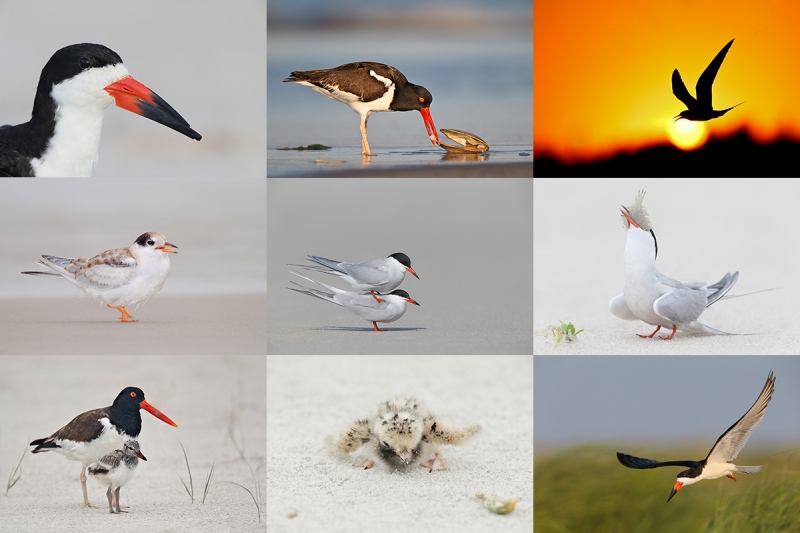
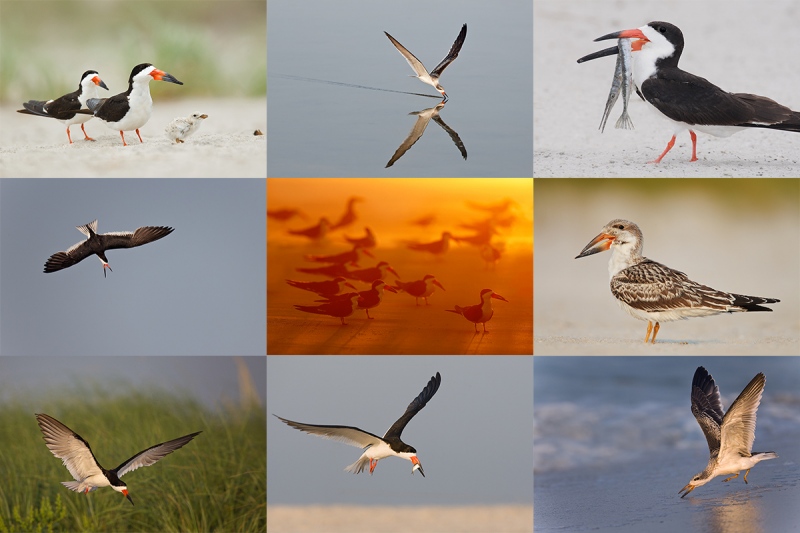
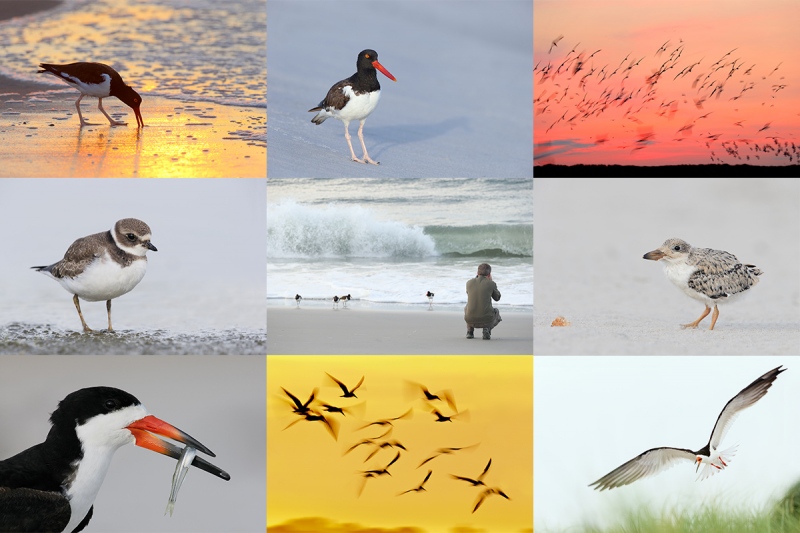
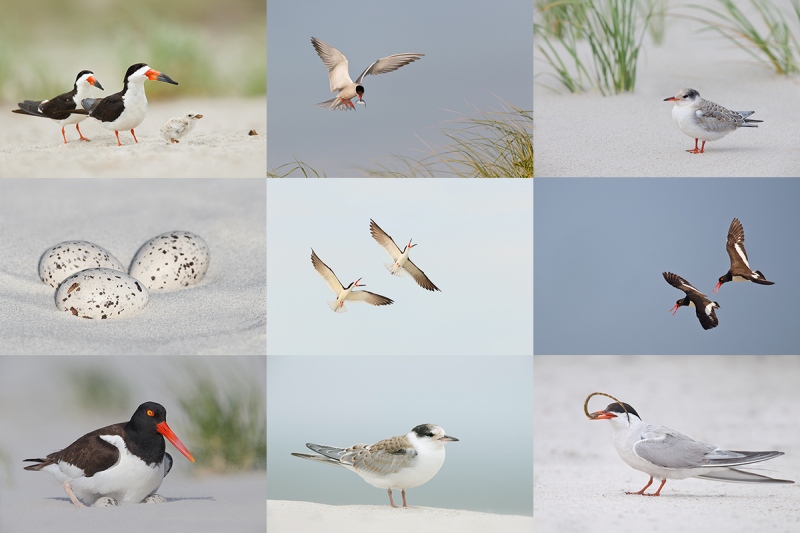
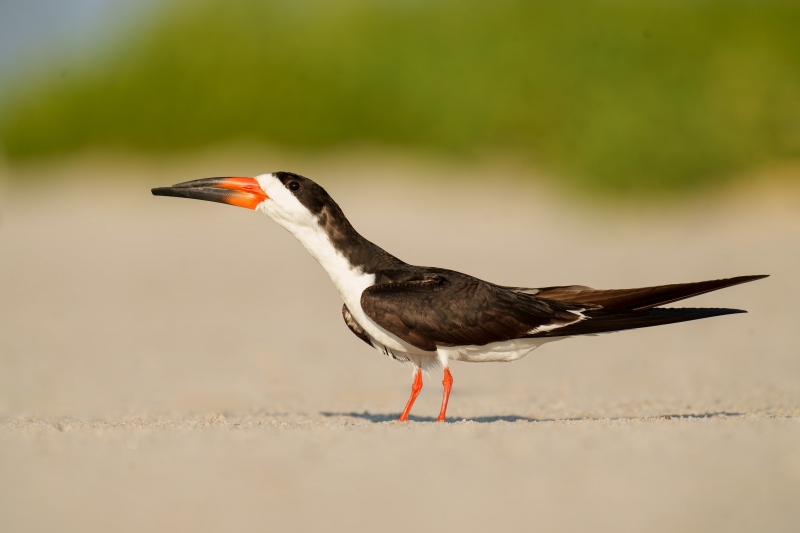
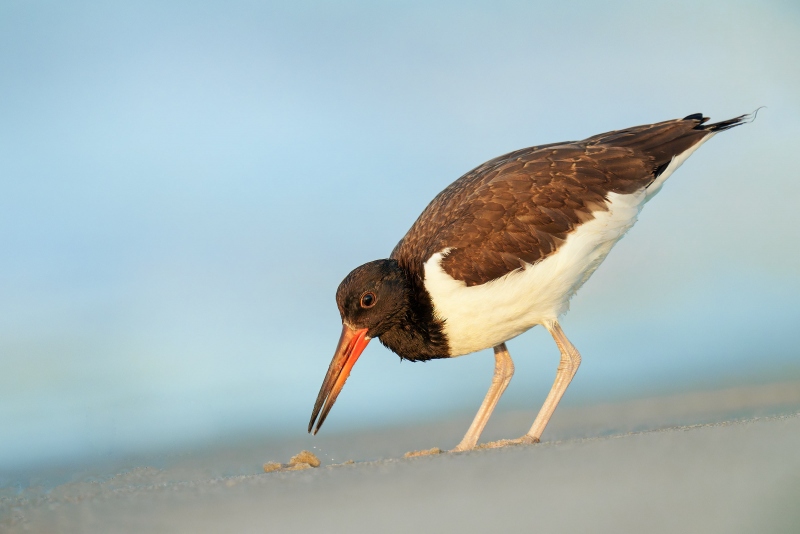
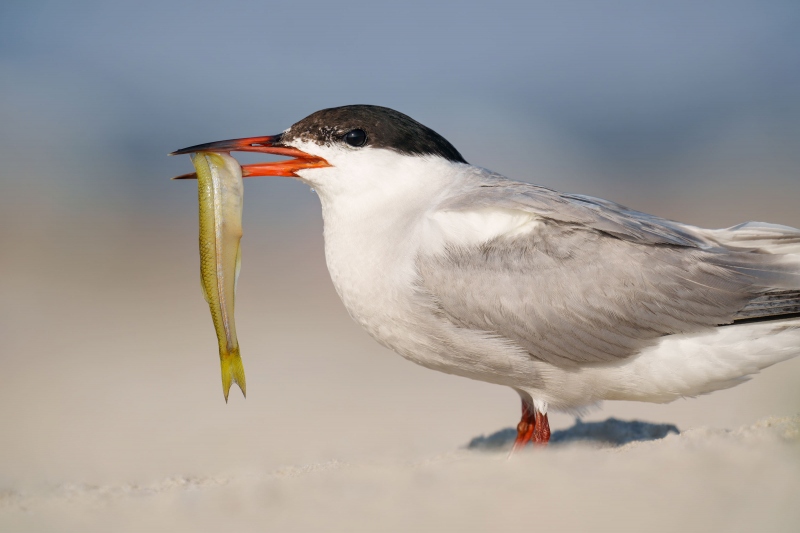
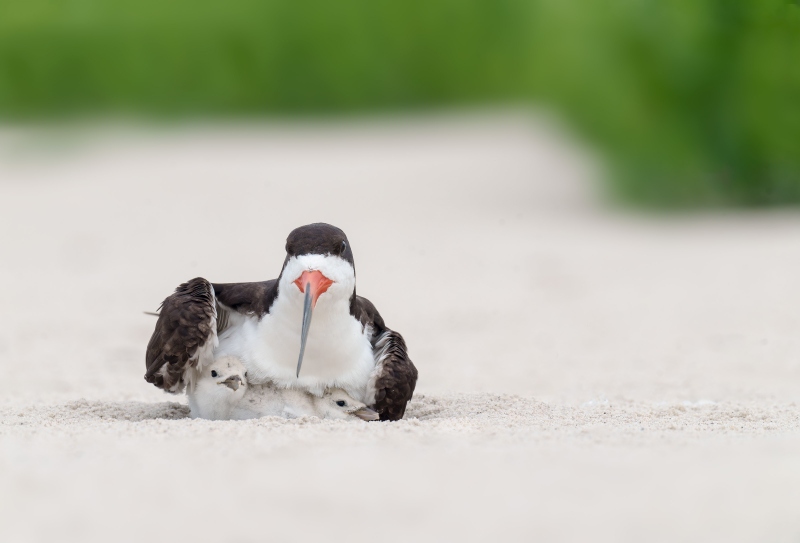













I believe you have a date typo for your first 2024 Nickerson Beach IPT. You say July 29 through Aug 1 for 3 1/2 days, starting the afternoon Monday, July 29 through the afternoon session on Thursday, August 8. I think you meant August 1.
Thanks, Gary, I believe that I screwed up both dates. They should be fixed now.
with love, a